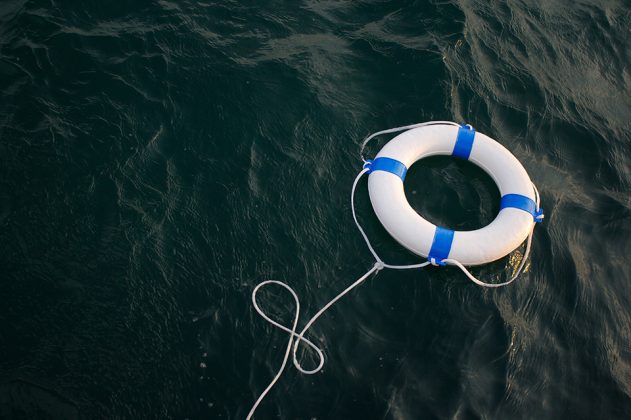FIRST AID –
#3 DROWNING
Words – Gordon Ingram
Over the last couple of articles we have looked at both the assessment of a patient and also how to deal with any minor injuries which they may have sustained. In this article we will look at an incident which is always possible with any water sport and that is the risk of drowning.
I think that it is true that each and every surfer/paddler has a comfort level. For some, it may be that they feel most at home bobbing around in a 2-3ft beach break, for others they may feel confident being towed behind a ski with 25-30ft bombs exploding around them. Whichever category you fall into the main points are exactly the same – Confidence and Comfort. I can put my hand on my heart (as I am sure most surfers can) and say that there have been several times when I have felt out of my comfort zone, usually because I have been coaxed out there by some Geordie charger telling me that it will all be ok! Thankfully, this has always been the case otherwise I wouldn’t be here writing this article.
However, there have been instances where surfers have ventured into the sea, to take on waves well within their ‘Comfort Levels’ and unfortunately not returned. Think, Mark Foo, Hawaiian big-wave charger, used to being in the ocean surrounded by massive walls of water. He sadly passed away surfing 20–25ft Mavericks, for the majority of us the sight of Mavericks breaking at 20-25ft would have us reaching for the cameras rather than choosing which board will do the job but for Mark this should have been a walk in the park. Interviews with friends afterwards stated he was tired, jet-lagged at not feeling 100%, again, how many of us have been drawn into the sea when not feeling 100%?
It would be stating the obvious to say that you are taking more risk when surfing larger waves but there is also a risk when surfing smaller ‘normal’ size waves, in fact the risk may be higher than we think as we become complacent and push ourselves further. All it takes is one lapse in concentration, a hit to the head, surfing a shallow reef and hitting the bottom, surfing a busy beachbreak and being involved in a collision, the list goes on….
So, what can we do? I am not saying we should all give up surfing and head to the gym (there is probably more risks involved by doing that!) What I am saying is that we should all be aware of what COULD happen.
“It would be stating the obvious to say that you are taking more risk when surfing larger waves but there is also a risk when surfing smaller ‘normal’ size waves, in fact the risk may be higher than we think as we become complacent and push ourselves further”
So what is drowning?
Drowning itself is quick and silent, although it may be preceded by distress which is more visible. A person drowning is unable to shout or call for help, or seek attention, as they cannot obtain enough air. The instinctive drowning response is the final set of autonomic reactions in the 20 – 60 seconds before sinking underwater, and to the untrained eye can look similar to calm safe behaviour. Lifeguards and other persons trained in rescue learn to recognize drowning people by watching for these instinctive movements.
Drowning is most often quick and unspectacular. Its media depictions of a loud, violent struggle have much more in common with distressed non-swimmers who may well drown but have not yet begun to drown. In particular, an asphyxiating person is seldom able to call for help. The instinctive drowning response covers many signs or behaviours associated with drowning or near-drowning:
• Head low in the water, mouth at water level
• Head tilted back with mouth open
• Eyes glassy and empty, unable to focus
• Eyes open, with fear evident on the face
• Hyperventilating or gasping
• Trying to swim in a particular direction but not making headway
• Trying to roll over on the back to float
• Uncontrollable movement of arms and legs, rarely out of the water.
Sea water is hypertonic to blood (more salty). Osmosis will instead pull water from the bloodstream into the lungs, thickening the blood. In animal experiments the thicker blood requires more work from the heart leading to cardiac arrest in 8 to 10 minutes.
So what can we do if someone drowns where we are surfing?
Rescue involves bringing the persons mouth and nose above the water surface. A drowning person may cling to the rescuer and try to pull himself out of the water, submerging the rescuer in the process. Thus it is advised that the rescuer approach with a buoyant object, or from behind, twisting the person’s arm on the back to restrict movement. If the rescuer does get pushed under water, they should dive downwards to escape the victim.
Special care has to be taken for people with suspected spinal injuries, and a back board (spinal board/paddleboard) may be needed for the rescue. In water, CPR is ineffective, and the goal should be to bring the casualty to a stable ground quickly and then to start CPR. Once on ground chest compressions are performed if the patient is pulseless, and if they are not breathing rescue breaths. Treatment for hypothermia may also be necessary.
As with any medical assistance, the level of care which you can provide will depend on the training you have received and the equipment you have available. I urge everyone who participates in water-sports to partake in lifeguarding or pre-hospital care course as the live you have save may be that of a friend or relative.
I hope that none of you have to act on this information but it is always better to be prepared!
Take care, stay safe, Gordon. SUP
For more information on Gordon’s courses visit www.firstresponsegb.com


